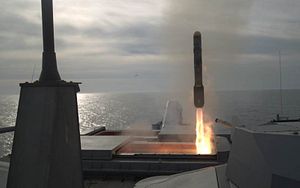The U.S. Navy’s Freedom-class Littoral Combat Ship (LCS) USS Detroit has conducted a successful structural test firing of its Surface to Surface Missile Module (SSMM) in late February, Naval Sea Systems Command revealed in a statement. (You can catch a short video of the test here.)
The SSMM is a 24-shot vertical launch system designed to engage smaller vessels in close proximity to the LCS (e.g., swarms of speedboats) with “fire-and-forget” Longbow Hellfire missiles vertically launched in rapid succession. (The estimated maximum range of the hellfire missile fired from the SSMM is approximately five miles.)
“The test marked the first launch of a missile from the SSMM from an LCS as well as the first vertical missile launched from an LCS, as part of the developmental test program for the Surface Warfare (SUW) Mission Package (MP),” according to the U.S. Navy statement.
The surface warfare mission package is slated to achieve initial operating capability (IOC) in 2018. Delays in the development of the SSMM led to the initial deployment of a more limited surface warfare mission package aboard the LCS exchanging hellfire missiles for rigid hull inflatable boats and boarding teams. The package also encompasses two 30 millimeter machine guns, two MQ-8B Fire Scout unmanned aerial vehicles and an MH-60S Seahawk helicopter.
The LCS’ design allows “modularity for operational flexibility,” according to the U.S. Navy by swapping out modules to provide different mission-specific capabilities including anti-submarine, surface warfare and mine-clearing. Nevertheless, every LCS, regardless of mission package, is armed with a BAE Systems 57 millimeter Mk 110 main gun and a 11-cell Raytheon RIM-116B SeaRAM missile-defense system.
“The testing aboard USS Detroit was an important milestone in advancing LCS capability, not only for the LCS community but for the entire fleet. As small boat threats proliferate, the SSMM will give our ships added lethality,” according to the USS Detroit’s commanding officer. A so-called structural test fire aims to verify that a ship’s structure and equipment are capable of withstanding the vibration, shock, noise, gases and other blast byproducts from the firing of a missile.
The U.S. Navy intends to induct 28 LCS and 12 more heavily armored and armed LCS classified as frigates. LCS are being built in two different variants. In addition to the mono-hull Freedom-class LCS, the U.S. Navy is also inducting the trimaran-hull Independence-class LCS, which features a larger flight deck, larger fuel capacity and as a result a wider operational range than a Freedom-class ship.
The USS Detroit is the fourth ship of the Freedom-class LCS variant following the USS Freedom, USS Fort Worth and USS Milwaukee, and was commissioned in October 2016. It is the seventh LCS to be commissioned by the U.S. Navy overall. The Freedom-class has been particularly accident prone and various vessels of the class were put out of action due to technical problems or human error last year.

































